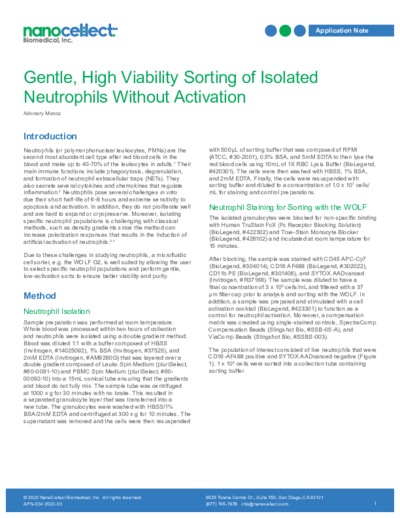Gentle, High Viability Sorting of Isolated Neutrophils Without Activation
Introduction
Neutrophils (or polymorphonuclear leukocytes, PMNs) are the second most abundant cell type after red blood cells in the blood and make up to 40-70% of the leukocytes in adults.1 Their main immune functions include phagocytosis, degranulation, and formation of neutrophil extracellular traps (NETs). They also secrete several cytokines and chemokines that regulate inflammation.2 Neutrophils pose several challenges in vitro due their short half-life of 6-8 hours and extreme sensitivity to apoptosis and activation. In addition, they do not proliferate well and are hard to expand or cryopreserve. Moreover, isolating specific neutrophil populations is challenging with classical methods, such as density gradients since the method can increase polarization responses that results in the induction of artificial activation of neutrophils.3,4
Due to these challenges in studying neutrophils, a microfluidic cell sorter, e.g. the WOLF G2, is well suited by allowing the user to select specific neutrophil populations and perform gentle, low-activation sorts to ensure better viability and purity.
Method
Neutrophil Isolation
Sample preparation was performed at room temperature. Whole blood was processed within two hours of collection and neutrophils were isolated using a double gradient method. Blood was diluted 1:1 with a buffer composed of HBSS (Invitrogen, #14025092), 1% BSA (Invitrogen, #37525), and 2mM EDTA (Invitrogen, #AM9260G) that was layered over a double gradient composed of Leuko Spin Medium (pluriSelect, #60-0091-10) and PBMC Spin Medium (pluriSelect, #60-00092-10) into a 15mL conical tube ensuring that the gradients and blood do not fully mix. The sample tube was centrifuged at ...
Want to read more?

